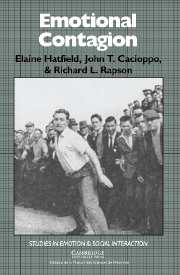Book contents
- Frontmatter
- Contents
- Acknowledgments
- Introduction and overview
- 1 Mechanisms of emotional contagion: I. Emotional mimicry/synchrony
- 2 Mechanisms of emotional contagion: II. Emotional experience and facial, vocal, and postural feedback
- 3 Evidence that emotional contagion exists
- 4 The ability to infect others with emotion
- 5 Susceptibility to emotional contagion
- 6 Current implications and suggestions for future research
- References
- Index
2 - Mechanisms of emotional contagion: II. Emotional experience and facial, vocal, and postural feedback
Published online by Cambridge University Press: 05 June 2012
- Frontmatter
- Contents
- Acknowledgments
- Introduction and overview
- 1 Mechanisms of emotional contagion: I. Emotional mimicry/synchrony
- 2 Mechanisms of emotional contagion: II. Emotional experience and facial, vocal, and postural feedback
- 3 Evidence that emotional contagion exists
- 4 The ability to infect others with emotion
- 5 Susceptibility to emotional contagion
- 6 Current implications and suggestions for future research
- References
- Index
Summary
The violinist Itzak Perlman, in trying to play a difficult note raises his eyebrows (if it is a high note) and keeps them raised until the note has been played … it is generally believed that these motions are secondary and ancillary. But suppose that a good part of musical memory is in fact lodged in these peculiar movements. Suppose that they are significant.
–Zajonc & Markus (1984, pp. 83–84)Introduction
We have defined emotional contagion as a multiply determined family of psychophysiological, behavioral, and social phenomena. In chapter 1, we reviewed evidence that there is a pervasive tendency automatically to mimic and synchronize expressions, vocalizations, postures, and movements with those of another person. This mimicry coordinates and synchronizes social interactions while freeing the interactants to think about other issues, such as what one or both of them are trying to achieve and what each is saying. In this chapter, we focus on another important but often overlooked consequence of mimicry: the tendency for mimicked acts to cultivate a convergence of emotions among the interactants. Thus,
Proposition 2. Subjective emotional experiences are affected, moment to moment, by the activation and/or feedback from such mimicry.
As was outlined in chapter 1, subjective emotional experience could theoretically be influenced by either:
the central nervous system commands that direct such mimicry/synchrony in the first place;
afferent feedback from such facial, verbal, or postural mimicry/synchrony; or
conscious self-perception processes, wherein individuals make inferences about their own emotional states on the basis of their own expressive behavior.
- Type
- Chapter
- Information
- Emotional Contagion , pp. 48 - 78Publisher: Cambridge University PressPrint publication year: 1993

